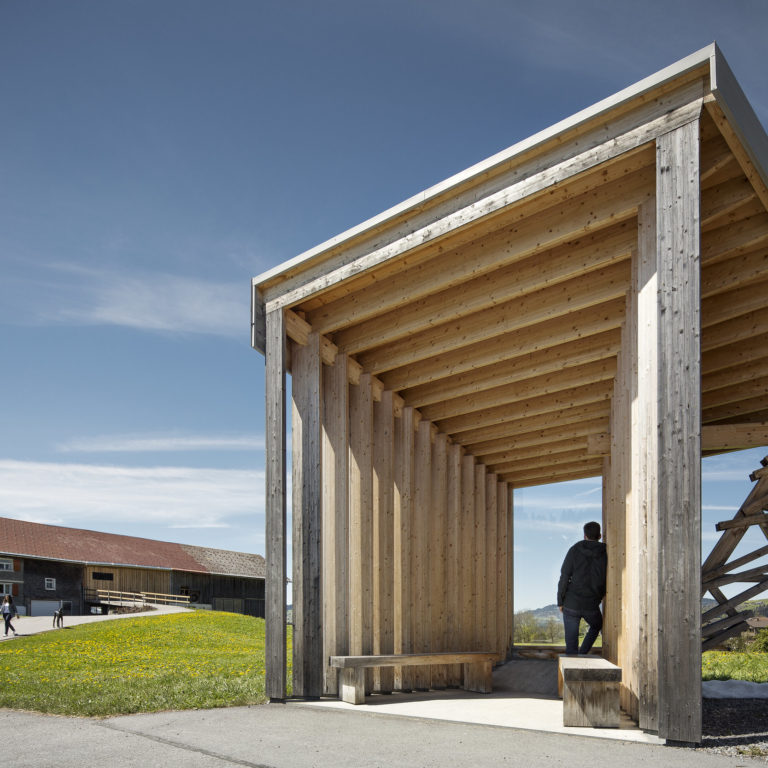
C Busstop Krumbach, Glatzegg © Albrecht Imanuel Schnabel / Vorarlberg Tourismus
BUS:STOP
How the big, wide world of architecture came to Vorarlberg

C Busstop Krumbach, Glatzegg © Albrecht Imanuel Schnabel / Vorarlberg Tourismus
How the big, wide world of architecture came to Vorarlberg
Bregenzerwald
Architects from all over the world designed bus stops for a village in the Bregenzerwald
TEXT: THOMAS ZWICKER
The yellow country bus is important to such small communities as Krumbach in the Bregenzerwald. As it became necessary to replace the bus shelters there, it was decided to combine everyday mobility and the culture of building – with bus-shelter designs by architects from all over the world
The big, wide world came to Krumbach. Sou Fujimoto came from Japan. Alexander Brodsky came from Russia. Smiljan Radic travelled from Chile. A total of seven architects from seven sometimes very distant countries, all of whom were not (yet) regarded as superstars in their field but who did enjoy some international renown, decided to participate in an extraordinary project. Each one of them designed their very own bus shelter for Krumbach that was then built in cooperation with local professional colleagues and tradespeople from the Bregenzerwald. And it was in this way that they helped the small village catapult itself on to the global map of architecture.
The 1,000-strong village of Krumbach lies right at the heart of the beautiful countryside of Vorarlberg. The culture of building and sound craftsmanship go back a long way here – as can already be seen in the neat and tidy village hall and parsonage. “Public transport plays an important role in rural life,” says the cosmopolitan local mayor (ret.) Arnold Hirschbühl, who loves his village all the more for all his travels. “The yellow country bus serves the village every 30 to 60 minutes.” When talk in the pub turned one day to the long overdue replacement of the village’s seven bus shelters, somebody had the bright idea of connecting the culture of building with everyday mobility and making a stand against cuts in “unprofitable” bus routes in rural areas – while at the same time bringing the big wide world of architecture to Krumbach.
“We simply wanted to make more out of our bus shelters,” says Arnold Hirschbühl. After all, the “kultur krumbach” association and the village as a whole have always been open to innovative ideas. Gebhard Wölfle, a vernacular poet who lived in the Bregenzerwald from 1848 to 1904, put it like this: “Meor ehrod das Ault, und grüssod das Nü.”
The region has always been open
to innovative ideas
In other words, we respect the old and welcome the new. The daring desire to win architects from afar to design the small bus shelters was appropriately taken to Dietmar Steiner, who has friends in Krumbach and, as the director of the Architekturzentrum in Vienna, also has many international contacts. At first he didn’t take the inquiry seriously and tried to kick it into the long grass. Krumbach insisted, Dietmar Steiner reconsidered and then caught fire. He got in touch with the renowned Vorarlberger Architektur Institut (vai), kept an eye out for young unconventional architects, selected seven protagonists who weren’t major stars in their global field but were exciting the sector by staking out their own artistic positions. Inquiries were dispatched.
“And, to our surprise, all seven agreed,” says Arnold Hirschbühl in retrospect, although the fee for the international architects was rather modest: just a plane ticket to view the localities, one week’s holiday for two in a hotel in the Bregenzerwald and that was it.
We simply wanted to make more out of our bus shelters
“The crazy thing about it was that it was the social and international aspects of the project that attracted the young stars,” says Steiner, who took on the role of curator. Along with an interest in the the culture of building and the local trades to be found in Vorarlberg as well as the collaboration. Volunteer contact architects were assigned to work with each international participant on an equal footing; they were given responsibility for supervising construction at site and for acting as the interface between design and implementation. Tradespeople from the entire region were won to help realise the project, most of whom also worked for free, and sponsors were found to bear the costs for materials.
When, in spring 2013, the architects arrived from all over the world to inspect the sites, they were impressed by the precision and care that characterise the work carried out by the tradespeople in Vorarlberg. And then they returned home to develop their projects. Their designs gradually arrived in summer, some as rough hand-drawn sketches, others detailed, and they all posed a whole range of different challenges to the local partner architects. Models were made and presented as the “BUS:STOP Krumbach” project at the Kunsthaus Bregenz. There was also some heated debate about ideas and feasibility. Hugo Dworzak, a Vorarlberg based architect from Lustenau, for example, remembers disputes with his partner from Russia: “Alexander Brodsky really wanted wooden shingles for the roofing on his bus shelter, which, however, the carpenter refused to do because they wouldn’t work as the roof wasn’t steep enough – Brodsky saw reason in the end.”
Krumbach’s residents, the innkeepers and restaurateurs as well as the members of the local associations were involved from the outset as far as possible. “Otherwise,” says Arnold Hirschbühl, “the whole thing wouldn’t have worked.” A topping-out ceremony was celebrated with the local residents whenever a bus shelter was completed. Initial scepticism didn’t last – the village mayor is thrilled to report, “One lady in the village, for example, is now so fond of the bus stop in front of her house that she cherishes and takes care of it as if it were her own.” The Verkehrsverbund Bregenzerwald, which operates the yellow country buses, is pleased as well. Friendships have developed between many of those involved. And culturally interested holiday-makers are delighted with the sometimes quirky designs.
Which could hardly have turned out any more different from each other. The spectrum of the new shelters ranges from a glass pavilion with black concrete ceiling and farmhouse chairs by Smiljan Radic from Chile (Zwing) to a station built from stacks of timber by Ensamble Studio from Spain (Unterkrumbach Nord) through to the metal structure by De Vylder Vinck Taillieu from Belgium (Unterkrumbach Süd). But the quirkiest is the one by Sou Fujimoto (Bränden), a forest consisting of white 4.5-centimetre thick steel rods between which a narrow set of steps spirals upwards – it affords no protection from the weather but the view from the top is magnificent and you can see the bus coming from afar. “For legal reasons, we had to put up a ‘no-entry’ sign,” says Mayor Hirschbühl, “but that disappeared very quickly…”
Krumbach’s BUS:STOP project has made a small bit of architectural history. It was only possible because residents, national and international architects, tradespeople and local politicians were prepared to work together. Krumbach’s school students also love the bus shelters by the architects from far away. They’ve composed an appropriate song with their teachers: “We’re going to see the big wide world with the country bus…”
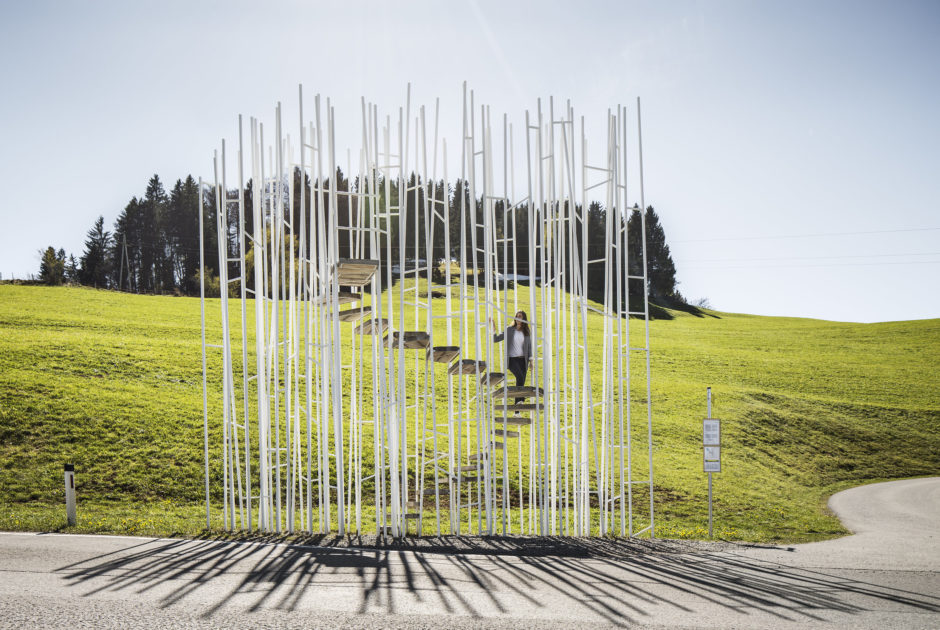
A structure that’s open at the top, made from thin steel rods with spiralling
steps, creates a new dimension in the perception of place, space and nature.
Architect: Sou Fujimoto, Japan
Local partner architects: Bechter Zaffignani Architekten, Bregenz
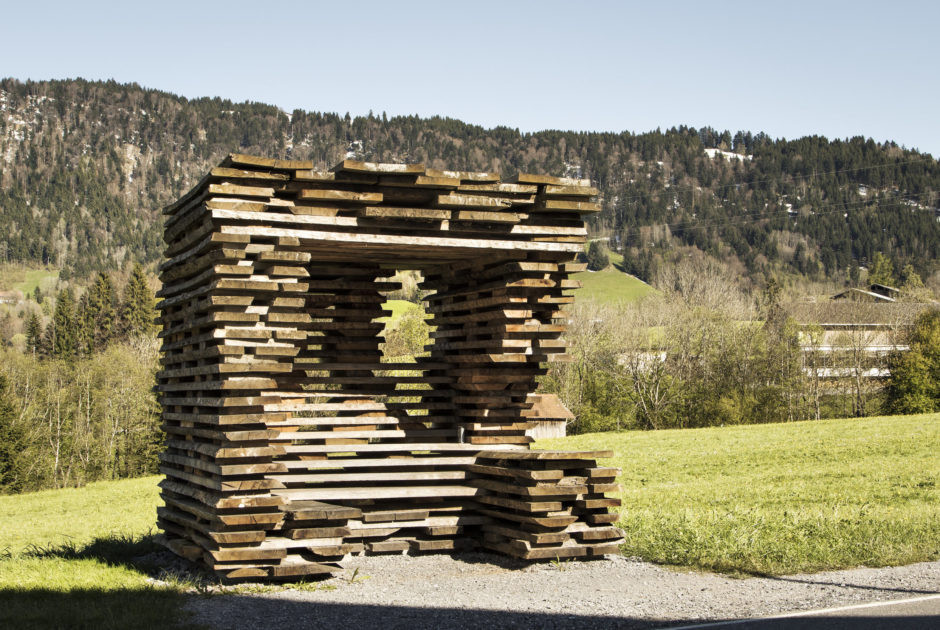
Layering of entirely untreated raw boards, inspired by the dry storage of timber at wood workshops throughout the Bregenzerwald.
Architects: Ensamble Studio, Antón García-Abril/Débora Mesa, Spain
Local partner architects: Dietrich/Untertrifaller Architekten, Bregenz/Vienna
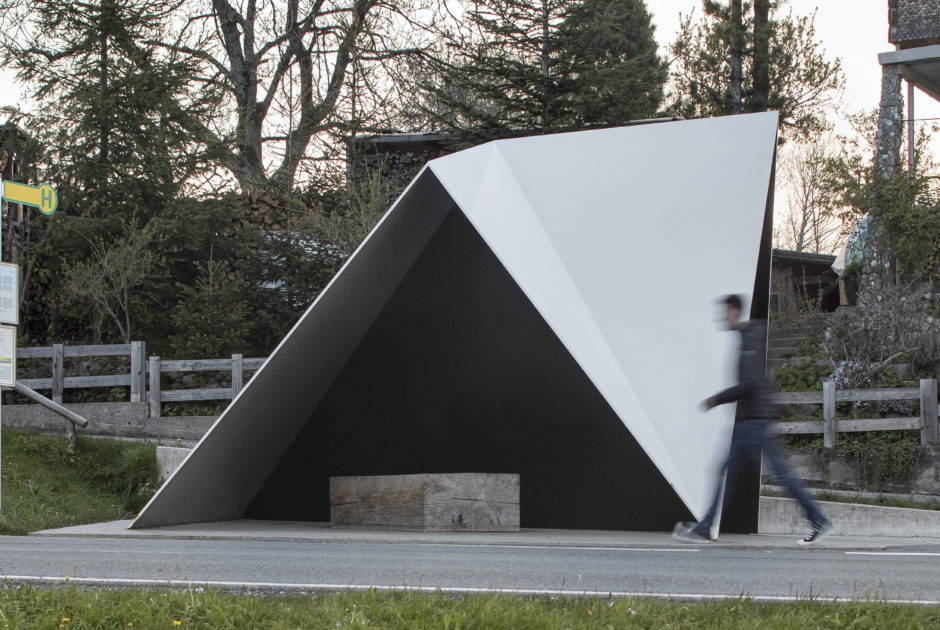
Acutely angled metal structure consisting of triangular planes, as a reflection of the snowcapped winter mountains.
Architects: De Vylder Vinck Taillieu, Belgium
Local partner architect: Thomas Mennel/MeMux, Schwarzenberg
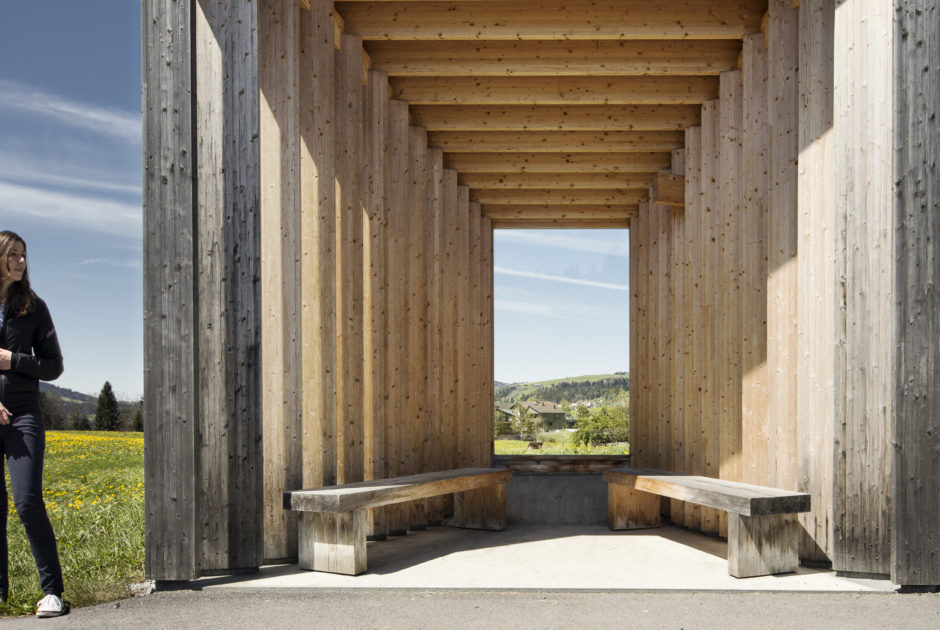
A camera obscura, the conical space opens up towards the road with a window facing the mountains on the rear wall.
Architect: Amateur Architecture Studio, China
Local partner architect: Hermann Kaufmann, Schwarzach
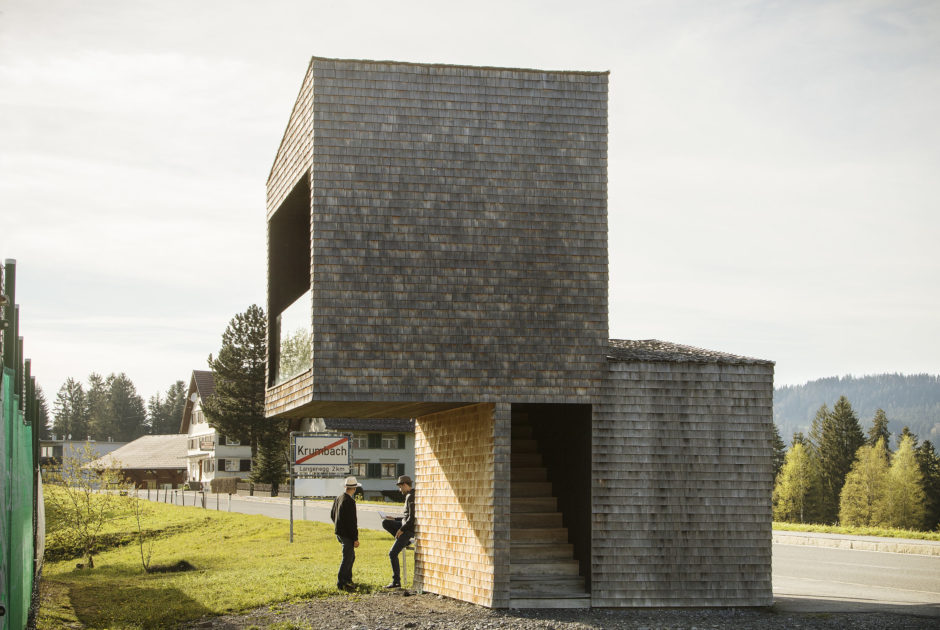
Two-storey timber structure, the top floor provides a view of the tennis
court at the rear to help while away waiting times.
Architects: Rintala Eggertsson Architects, Norway
Local partner architects: Baumschlager Hutter Partners, Dornbirn
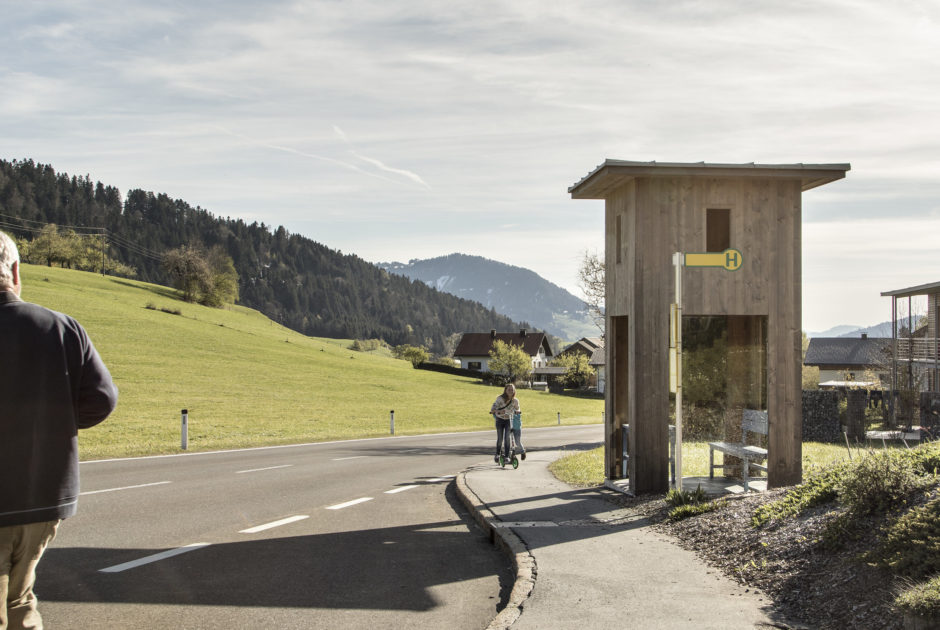
Wooden tower in a confined space, glazed at the bottom, with table and
bench, openings in the top “for birds to fly through”.
Architect: Alexander Brodsky, Russia
Local partner architect: Hugo Dworzak, Architekturwerkstatt Dworzak, Lustenau
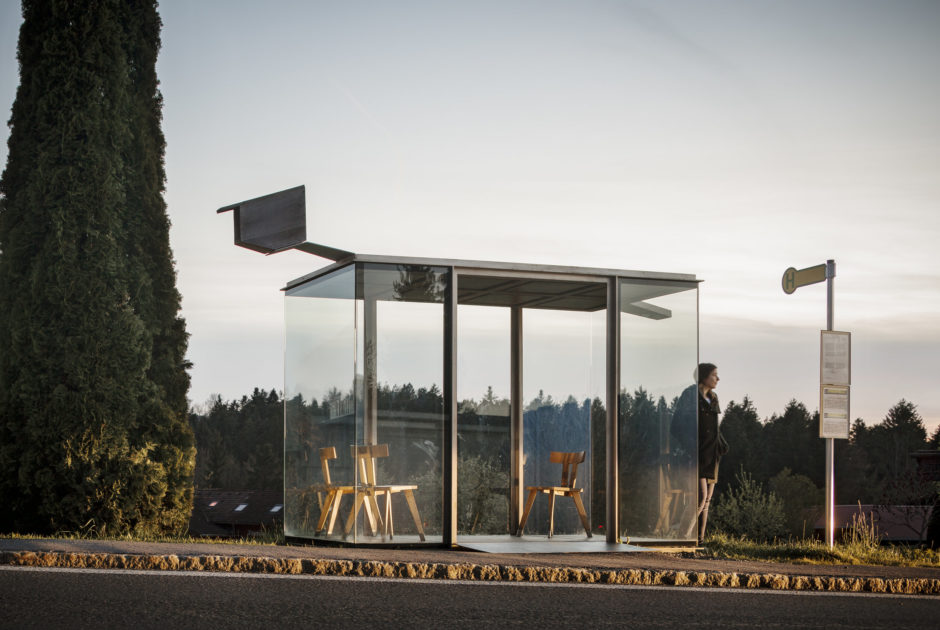
Glass pavilion with coffered ceiling made from black concrete, farmhouse
chairs, a birdhouse fitted at the top on the side as an eye-catcher.
Architect: Smiljan Radic, Chile
Local partner architect: Bernardo Bader Architekten, Dornbirn